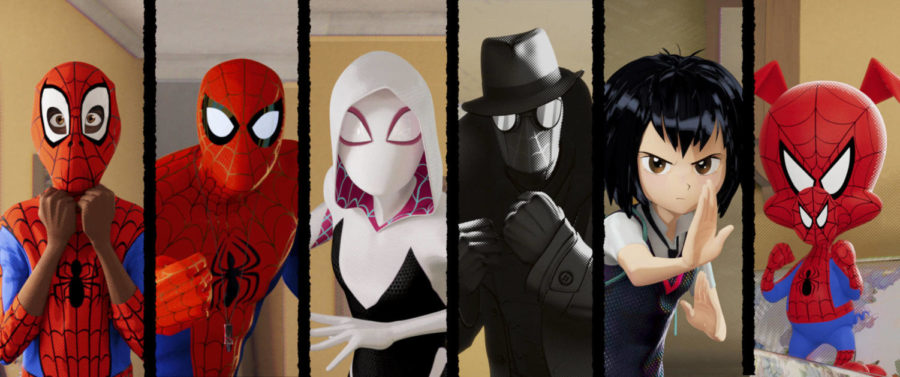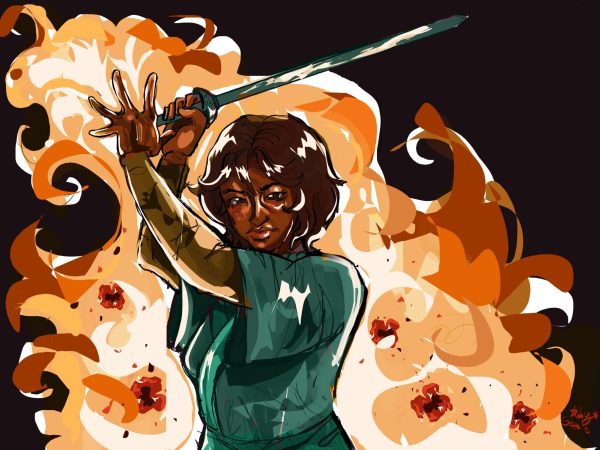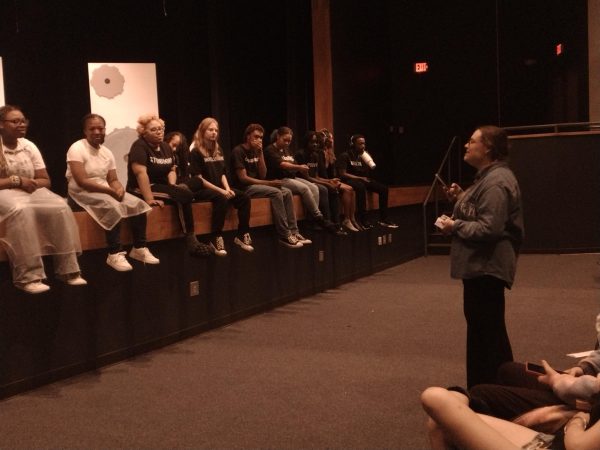Power moves: Spider-man: Into the Spiderverse Review
Everyone and their cousin knows who spider-man is by now. A web-slinging, do it all dynamo, but no one knows about his extended universe. Into the Spider-verse explores the extended world of the Spider-verse that Stan-lee created long, long ago. Into the Spider-verse is an action style animation which was released December 2018.
The premise follows Miles Morales (voiced by Shameik Moore), an Afro-Latino who lives in Brooklyn and is attending a high school for gifted children. Miles doesn’t want to be there though, and instead wants to hang out with his uncle (played by Mahershala Ali). One night the two begin tagging and underground runway for an abandoned piece of the subway, when a radioactive spider happens to get into Miles’s hoodie– and a classic story begins where another ends, because the next day the Peter Parker in Miles’s universe ends up dying.
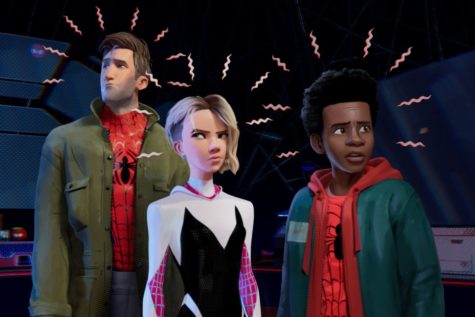
Verse for Verse
Visually, there’s a ton to unpack from the Spiderverse. Firstly is the fact that being animated works to the movie’s advantage. The entire movie is done in a comic book style, paying homage to the original comics. There’s many textures and even smaller details such as action lines when characters are loud, thought panels, and more. The vibrant color is put to good use to indicate various tensions and moods. For instance, when Miles ends up back in the abandoned railway the first time in the movie, we get a flash of red and blue in the background to show his anxiety, and then reversed again as the impending danger he sensed came crashing through the window behind him. The way the scene was shot allows for the viewer to share the impending doom due to the intense colors being used. There’s another scene near the end where the time machine breaks and it unleashed a flood of colors that filled the screen. So the contrast that happens when Kingpin (voice by Liev Schreiber) goes after Miles and the colors slowly become more and more black as Kingpin is about to kill him makes it all the more a powerful scene.
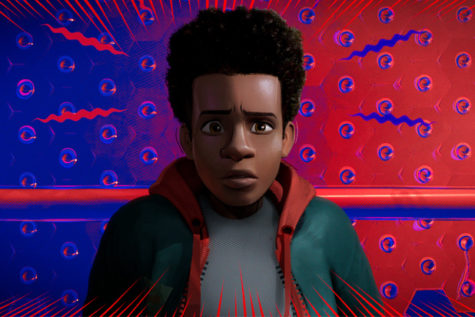
Honestly, with the amount of good qualities this movie has, the bad qualities seem so minor. Most criticisms are technical, though there are a few thematic issues. Firstly, the bright colors may be a bit daunting to even those who don’t have epilepsy, especially when seen in a dark room or theater. The thematic critiques are more-or-less minor themselves. There’s a lot of cliches, granted the movie uses comic book tropes as a stylistic choice, introducing every new spider-person with their comic cover, and the cliches are played on a little bit here like Miles being a young ‘boy wonder’ looking up to the spider-man from his universe, but then that spider-man dying and immediately after Miles being burdened with the task of saving his universe. This subverts the trope, combining the classic ‘chosen one with a job’ in which the hero is young and has a purpose, and the ‘master and the young scholar’ trope in that Peter B (played by Jake Johnson) doesn’t actually want to teach Miles like his counterpart did. Even then, the use of the previous trope kind of offers some thoughtful commentary, giving us semi-meta dialogue on how Miles ‘doesn’t have’ a choice in what responsibility he’s given because of the power bestowed to him. But in his characterization and his dialogue up to the point of him finally accepting his responsibility, it’s made clear to the audience that Miles isn’t ready– he’s only a sophomore after all. He feels overwhelmed and almost as if he’ll never be ready. This is reiterated in scenes like when he first gets his powers, when he’s put through trials by the other spider people, when going into his uncle’s apartment he’s writing a letter only to be nearly discovered by the Prowler, Miles lets his feelings and emotions be known with how overwhelmed he is. This choice in portrayal captures the original spirit of Peter Parker, in that he starts out a naive, terrified child and ends his story being the hero New York needs.
Webbing It In
The acting can’t be commented on too much, as it’s pretty phenomenal. The only odd choice in mind is probably the appearance of Peter Porker (played by John Mulaney.) However, Porker’s purpose is literal comic relief, so it’d be nitpicking at that point. Instead, it’d be better to talk about character dynamism here, rather than the acting itself. The spider-people are a colorful group of characters, all from different universes.

For spiders that haven’t been addressed already, Peni Parker (played by Kimiko Glenn) stands out by an extreme extent from the other characters. To begin with, Peni’s story is ripped from the Spider-man manga “Sp//dr”, where Peter Parker is her father, but tragically died after building the Sp//dr mecha. She’s bitten by a psychic spider and pilots the mecha alongside the spider. What makes her unique is that firstly, her animation is entirely in a traditional manga style– even her expressions are even more exaggerated than her western originated teammates. Even her form of fighting is unique, as giant robot driving is a manga unique trope. This is significant since while all the styles contrast in some way, hers contrasts the most since the very nationality of her origin style is different, bringing a bit of culturally diverse artistic value to the table.
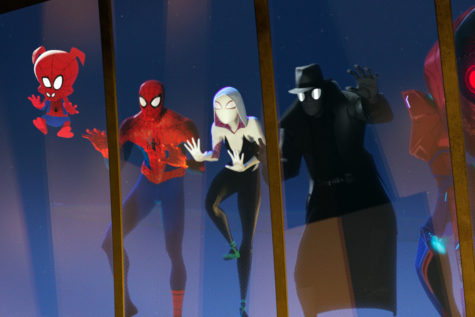
Spider-Ham (John Mulaney) Peter Parker (Jake Johnson), Spider-Gwen (Hailee Steinfeld), Spider-Man Noir (Nicolas Cage), and SP//DR in Columbia Pictures and Sony Pictures Animation’s SPIDER-MAN: INTO THE SPIDER-VERSE.
Next we have Spider Noir (played by Nicholas Cage), a spider-man from the Great Depression who fights Nazis and is a journalist. Color wise, he’s an oddball compared to his team mates. While everything else is characteristically bright and colorful, Noir is black and white. Clearly to reflect the noir style of crime movies common to the time period. We’re given a more historically steeped character with Noir that’s also, personality wise, a nice contrast to the high energy team. While yes, Peter B. Parker could also be considered to be depressed and somewhat edgy himself, Noir’s character is more grounded. Compared to the others who have more idealistic dialogue, Noir is more realistic if not just pessimistic.
Then we have Peter Porker, the previously stated comedic relief. He’s really just a parody of spider-man, taking place in a more cartoon like universe resembling that of the Looney Tunes. The unique thing about Porker is that he’s almost excessively different. Even in the final fight scene, he uses a cartoon mallet to fight. The reason Porker is significant is because of how identifiable he is. There’s a lot of things putting and forcing him into his role. But at the same time, he does have moments in which he’s able to be serious. He’s not just a funny guy from a funny world. Because of the contrasting moment where Porker is serious, it reinforces one of the main overarching themes of “it’s okay to be different, just remember you’re not different alone.”
Pinned Down
Into The Spiderverse has sparked a large amount of discussion among the American animation community because of the artistic value versus how animation is treated among American audiences. Specifically, the fact that American movie companies tend not to invest into animated movies frequently because of the myth that animation is a genre reserved for children.
What makes Spiderverse significant though is that there’s clearly more mature, more hard hitting themes. It’s an artistic masterpiece from a cinematic standpoint and even went on to become Sony’s highest grossing film as of January 31st. It’s this reason specifically that animators are speaking out against the unfairness that’s referred to by many as “Animation Age Ghetto,” in which animation has been deemed too childish of a medium to depict more adult, emotionally gripping stories in.
This is the one movie that finally took a risk avoiding the "animation age ghetto" when working with two writers who wrote the Lego movie, a first animated Spiderman movie.
— Denise Walker (@Dabathhouse) December 26, 2018
Punching Up
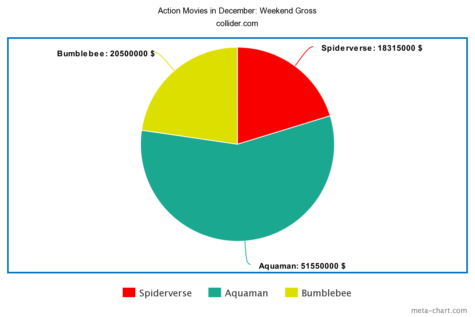
The most anticipated action films during the month of December included Spiderverse, Aquaman, and Bumblebee. Aquaman managed to earn the most opening weekend at $515,500,000, followed by Bumblebee at $205,000,000. Spiderverse, however, managed to cut close to a tie with Bumblebee at $183,150,000. Though this chart may be reflective the earlier mentioned ‘animation ghetto,’ and Spiderverse’s attempts to break out of those boundaries, it’s undeniable people were eagerly anticipating how DC would handle Aquaman, especially after the premiere of Wonder woman in 2017.
With Great Power….
In short, there’s no real reason not to watch Spiderverse. With its colorful imagery and deep thematic messages, it’s a little more than a ‘family film.’ It’s an emotionally gripping coming of age story from the point of view of a boy who was forced into a destiny he could control. At the end of the movie, it’s worth noting the late Stan Lee who died before the movie was released was quoted in the end credits.
“That person who helps others simply because it should or must be done, and because it is the right thing to do, is indeed without a doubt, a real superhero.” – Stan Lee
Regardless of your opinion on animated films, it’s undeniable the cultural impact this movie has on the viewers. One of the driving thematic messages in the film is that ‘although you are different, you are never alone.’ Miles is constantly having an internal battle with himself regarding his purpose and role as a hero in the film and the self doubts he carries. If anyone still has hangups about seeing this movie, do it. It’s a masterpiece in animation, and a marvel of a film.
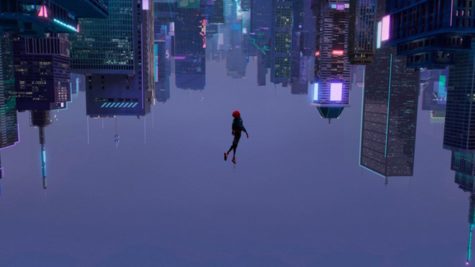
TL;DR: This is a wonderful animated film and possibly one that will leave some sort of cultural impact; recommended watch for everyone regardless of age. 10/10


